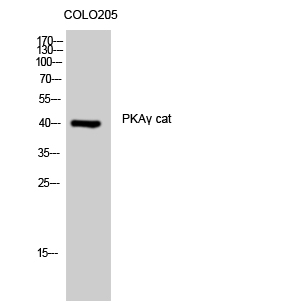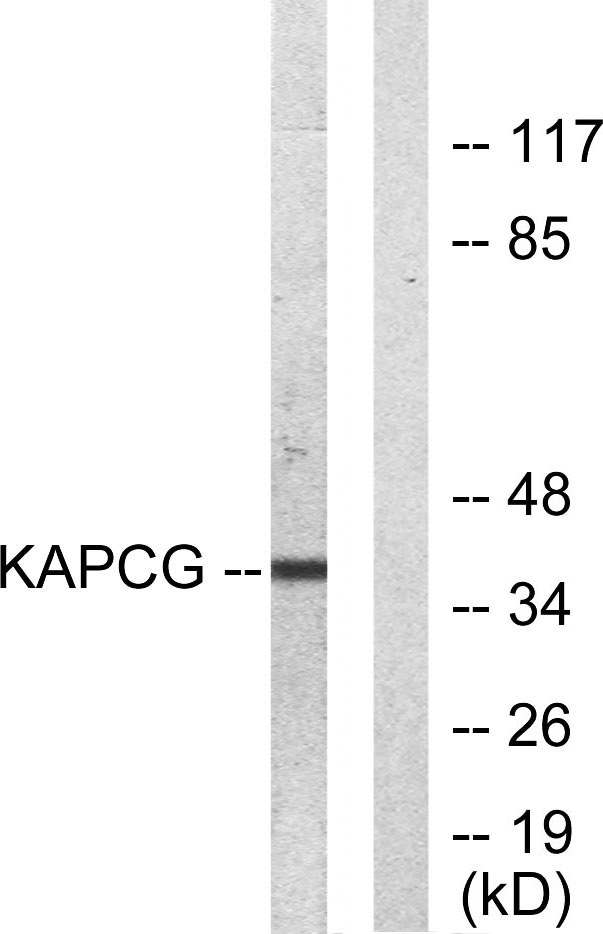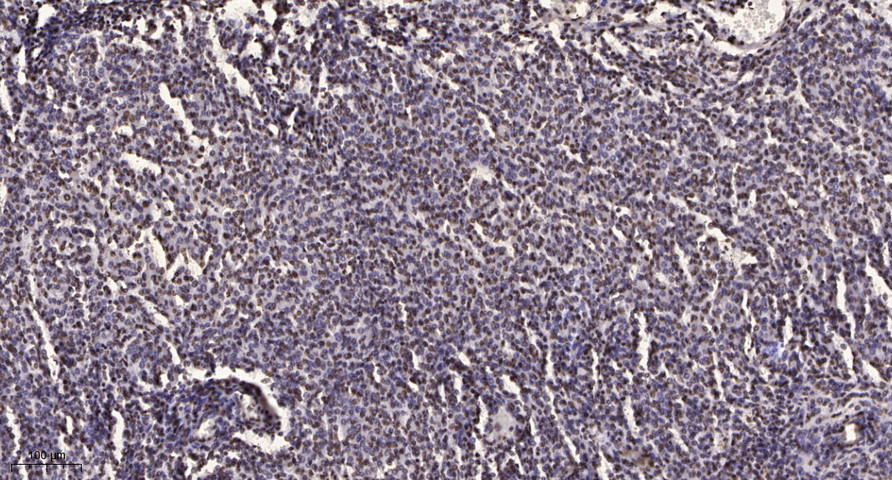PKAγ cat Polyclonal Antibody
- Catalog No.:YT3751
- Applications:WB;IHC;IF;ELISA
- Reactivity:Human;Rat;Mouse;
- Target:
- PKAγ cat
- Fields:
- >>Endocrine resistance;>>MAPK signaling pathway;>>Ras signaling pathway;>>Calcium signaling pathway;>>cAMP signaling pathway;>>Chemokine signaling pathway;>>Oocyte meiosis;>>Autophagy - animal;>>Longevity regulating pathway;>>Longevity regulating pathway - multiple species;>>Adrenergic signaling in cardiomyocytes;>>Vascular smooth muscle contraction;>>Wnt signaling pathway;>>Hedgehog signaling pathway;>>Apelin signaling pathway;>>Tight junction;>>Gap junction;>>Platelet activation;>>Circadian entrainment;>>Thermogenesis;>>Long-term potentiation;>>Retrograde endocannabinoid signaling;>>Glutamatergic synapse;>>Cholinergic synapse;>>Serotonergic synapse;>>GABAergic synapse;>>Dopaminergic synapse;>>Olfactory transduction;>>Taste transduction;>>Inflammatory mediator regulation of TRP channels;>>Insulin signaling pathway;>>Insulin secretion;>>GnRH signaling pathway;>>Ovarian steroidogenesis;>>Progesterone-mediated oocyte maturation;>>Estrogen signaling pathway;>>Melanogenesis;>>Thyroid hormo
- Gene Name:
- PRKACG
- Protein Name:
- cAMP-dependent protein kinase catalytic subunit gamma
- Human Gene Id:
- 5568
- Human Swiss Prot No:
- P22612
- Immunogen:
- The antiserum was produced against synthesized peptide derived from human KAPCG. AA range:1-50
- Specificity:
- PKAγ cat Polyclonal Antibody detects endogenous levels of PKAγ cat protein.
- Formulation:
- Liquid in PBS containing 50% glycerol, 0.5% BSA and 0.02% sodium azide.
- Source:
- Polyclonal, Rabbit,IgG
- Dilution:
- WB 1:500 - 1:2000. IHC 1:100 - 1:300. ELISA: 1:10000.. IF 1:50-200
- Purification:
- The antibody was affinity-purified from rabbit antiserum by affinity-chromatography using epitope-specific immunogen.
- Concentration:
- 1 mg/ml
- Storage Stability:
- -15°C to -25°C/1 year(Do not lower than -25°C)
- Other Name:
- PRKACG;cAMP-dependent protein kinase catalytic subunit gamma;PKA C-gamma
- Observed Band(KD):
- 40kD
- Background:
- Cyclic AMP-dependent protein kinase (PKA) consists of two catalytic subunits and a regulatory subunit dimer. This gene encodes the gamma form of its catalytic subunit. The gene is intronless and is thought to be a retrotransposon derived from the gene for the alpha form of the PKA catalytic subunit. [provided by RefSeq, Jul 2008],
- Function:
- catalytic activity:ATP + a protein = ADP + a phosphoprotein.,enzyme regulation:Activated by cAMP.,function:Phosphorylates a large number of substrates in the cytoplasm and the nucleus.,similarity:Belongs to the protein kinase superfamily. AGC Ser/Thr protein kinase family. cAMP subfamily.,similarity:Contains 1 AGC-kinase C-terminal domain.,similarity:Contains 1 protein kinase domain.,subunit:A number of inactive tetrameric holoenzymes are produced by the combination of homo- or heterodimers of the different regulatory subunits associated with two catalytic subunits. cAMP causes the dissociation of the inactive holoenzyme into a dimer of regulatory subunits bound to four cAMP and two free monomeric catalytic subunits.,tissue specificity:Testis specific. But important tissues such as brain and ovary have not been analyzed for the content of transcript.,
- Subcellular Location:
- nucleoplasm,cytosol,ciliary base,
- Expression:
- Testis specific. But important tissues such as brain and ovary have not been analyzed for the content of transcript.
- June 19-2018
- WESTERN IMMUNOBLOTTING PROTOCOL
- June 19-2018
- IMMUNOHISTOCHEMISTRY-PARAFFIN PROTOCOL
- June 19-2018
- IMMUNOFLUORESCENCE PROTOCOL
- September 08-2020
- FLOW-CYTOMEYRT-PROTOCOL
- May 20-2022
- Cell-Based ELISA│解您多样本WB检测之困扰
- July 13-2018
- CELL-BASED-ELISA-PROTOCOL-FOR-ACETYL-PROTEIN
- July 13-2018
- CELL-BASED-ELISA-PROTOCOL-FOR-PHOSPHO-PROTEIN
- July 13-2018
- Antibody-FAQs
- Products Images

- Western Blot analysis of COLO205 cells using PKAγ cat Polyclonal Antibody

- Western blot analysis of lysates from COLO205 cells, using KAPCG Antibody. The lane on the right is blocked with the synthesized peptide.

- Immunohistochemical analysis of paraffin-embedded human brain tumor. 1, Antibody was diluted at 1:200(4° overnight). 2, Tris-EDTA,pH9.0 was used for antigen retrieval. 3,Secondary antibody was diluted at 1:200(room temperature, 45min).



